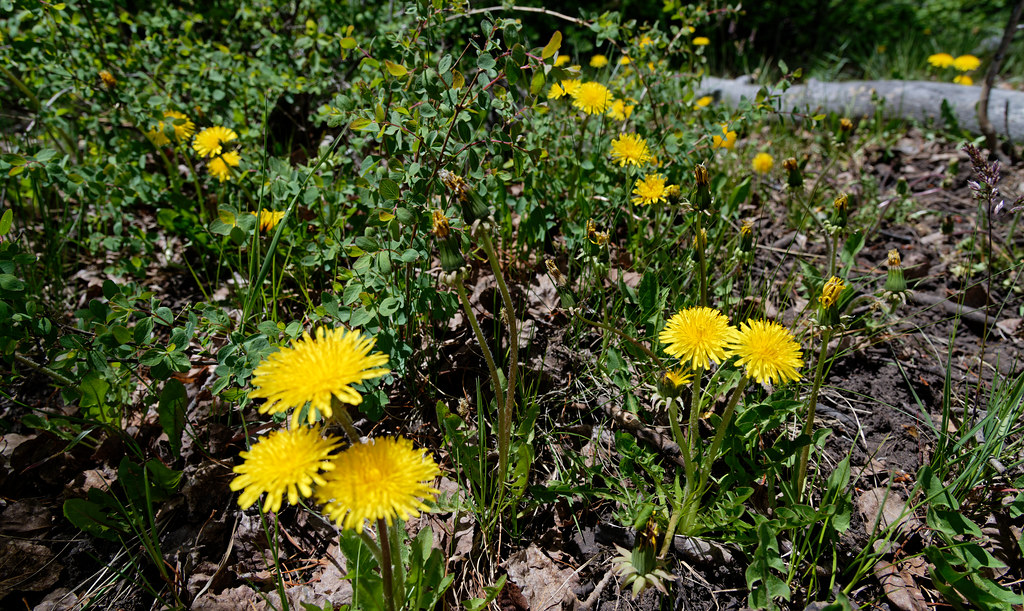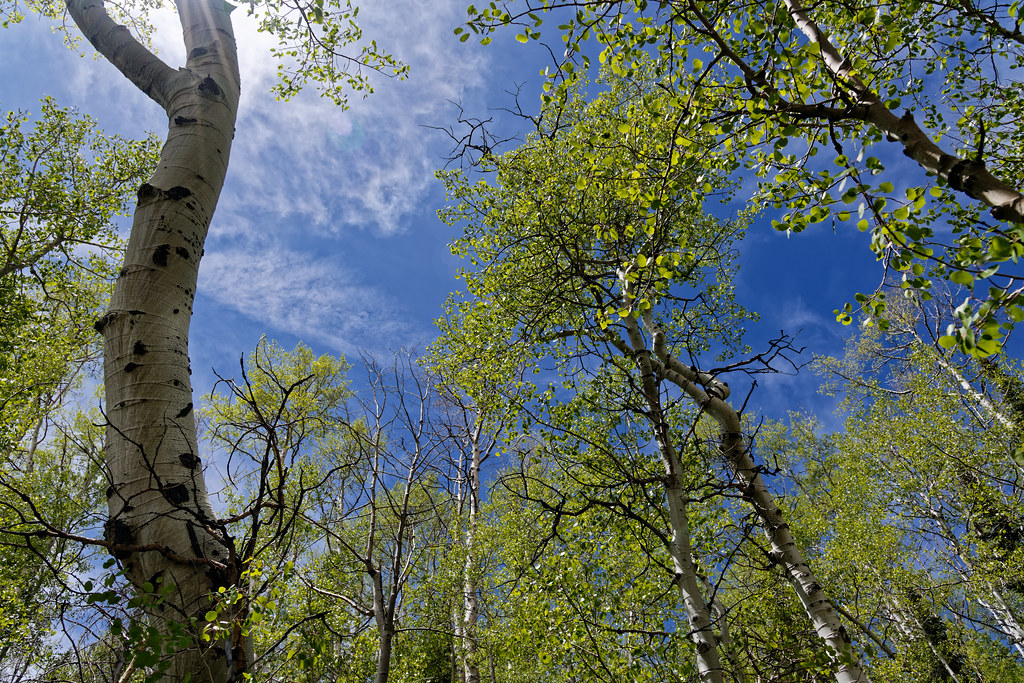#fishlake national forest
Text

A group of campers relax around a fire on a cool spring day.
Fishlake National Forest, Utah
1938
59 notes
·
View notes
Photo
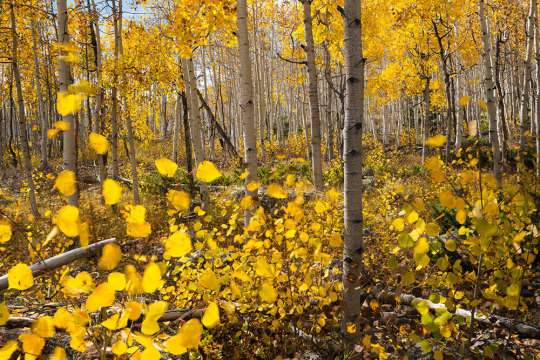
A grove of quaking aspens in Utah’s Fishlake National Forest.
PHOTOGRAPH BY DIANE COOK AND LEN JENSHEL, NAT GEO IMAGE COLLECTION
#diane cook#len jenshel#photographers#national geographic#aspen grove#tree#utah#fishlake national forest#landscape#nature#autumn
25 notes
·
View notes
Text
Pando, The Trembling Giant of Utah is the World's Biggest Organism
Situated in Utah’s Fishlake National Forest, there’s a giant living wonder called Pando.
This isn’t just any tree—it’s what scientists call the largest single organism on Earth. Known affectionately as “The Trembling Giant,” Pando looks like a forest made up of individual aspen trees, but it’s actually all connected underground by one root system, making up one gigantic living being.
The Pando…

View On WordPress
0 notes
Video
Dandelions in Utah by Mark Stevens
Via Flickr:
A look across a small field of dandelions in Fishlake National Forest. This is at a roadside pullout along Utah Scenic Byway 12. I got down low using the LCD display with LiveView on my Nikon SLR camera to line up and compose this image.
#Aquarius Plateau#Azimuth 282#Blue Skies with Clouds#Canyonlands#Colorado Plateau#Dandelion#Dandelions#Day 3#DxO PhotoLab 5 Edited#Fishlake National Forest#Intermountain West#Landscape - Scenery#Looking NW#Nikon D850#No People#Outside#Partly Cloudy#Project365#Rolling Hillsides#Scenic Byway 12#Scenics - Nature#SnapBridge#Southern Utah and Great Basin National Parks#Spruce Spring#Sunny#Taraxacum#Travel#Wildflower#Wildflowers#Utah
0 notes
Text
13 Places to Visit While Road Tripping Through Southern Utah
For this three day weekend we decided to head to one of our most favorite places to visit, Utah, to explore some of their back country roads. We had no plans except to start near Zion National Park.
May 2022
For this three day weekend we decided to head to one of our most favorite places to visit, Utah, to explore some of their back country roads. We had no plans except to start near Zion National Park. Below you will find our video and all our stops along the way with some amazing scenic drives.
Eddie World
Our trips down the 15 always start at the Eddie World right outside of Barstow…

View On WordPress
#beaver canyon scenic byway#beaver river#beaver tacos#brown trout#Caves#creamery in beaver#cutthroat#disperse camping#dixie national forest#duck creek ice cave#duck creek village#Eddie world#enterprise reservoir#fish lake#fish lake national park#fish lake scenic byway#fish utah#fishing utah#FishLake national park#FishLake scenic byway#ice caves#kolob reservoir#lava caves#mammoth lava cave#mill meadows reservoir#overlanders#Overlanding#puffer lake#rainbow trout#road trip vibes
1 note
·
View note
Text

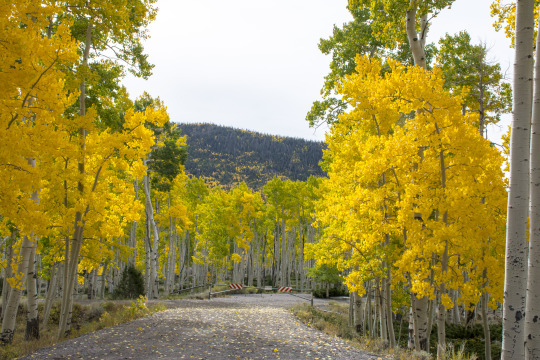
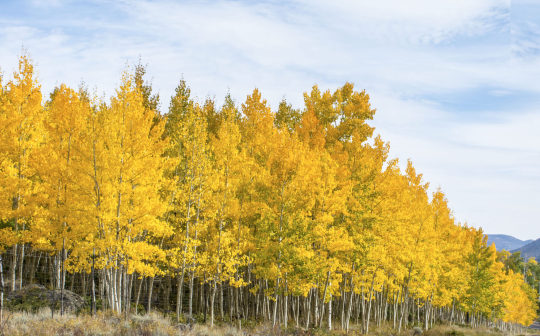
Al asombroso árbol "Pando"-Una maravilla de la naturaleza
En el corazón del bosque Fishlake National Forest, en el estado de Utah, Estados Unidos, se encuentra una maravilla natural única: el árbol Pando. Este coloso arbóreo no se destaca por su altura imponente ni por su frondosidad, sino por su asombrosa habilidad para replicarse y formar un extenso bosque clonal. Conocido como el "Trembling Giant" (gigante tembloroso), el árbol Pando es, de hecho, un organismo singular que despierta el interés y la admiración de científicos y amantes de la naturaleza por igual.
El árbol Pando pertenece a la especie de álamo temblón (Populus tremuloides), y lo que lo hace verdaderamente extraordinario es su modo de reproducción. A diferencia de otros árboles, el Pando se propaga principalmente a través de brotes subterráneos llamados rizomas. Estos rizomas emergen del tronco principal y se extienden bajo tierra, dando lugar a nuevos árboles genéticamente idénticos al árbol original.
El resultado es un bosque clonal compuesto por miles de álamos temblones que comparten el mismo material genético. Aunque individualmente estos árboles puedan parecer distintos, todos son genéticamente idénticos, lo que convierte al Pando en uno de los organismos más grandes y antiguos del mundo. Se estima que el bosque clonal de Pando tiene más de 80,000 años, lo que lo convierte en uno de los organismos más antiguos del planeta.
A pesar de su longevidad y resistencia, el árbol Pando enfrenta desafíos significativos. La actividad humana, la alteración del hábitat y el cambio climático amenazan la salud y la viabilidad de este bosque clonal. La conciencia y la conservación son fundamentales para preservar esta maravilla natural única.
La importancia del árbol Pando va más allá de su singularidad biológica. Este gigante tembloroso nos enseña sobre la interconexión de los seres vivos y la capacidad de la naturaleza para adaptarse y persistir a lo largo del tiempo. Su historia evolutiva es un testimonio de la resistencia de la vida en la Tierra y nos recuerda la necesidad imperante de proteger y preservar nuestro medio ambiente.
Visitar el bosque Fishlake National Forest y contemplar el árbol Pando es una experiencia única. Observar la vastedad de este bosque clonal y reflexionar sobre su historia evolutiva invita a la admiración y la reflexión sobre la fragilidad de la naturaleza y la responsabilidad que tenemos como guardianes de nuestro planeta.
En resumen, el árbol Pando no es simplemente un grupo de álamos temblones en un bosque remoto; es una lección viva sobre la resistencia, la interconexión de la vida y la importancia de conservar nuestras maravillas naturales. Cuidar del árbol Pando es cuidar de un tesoro biológico que ha resistido el paso del tiempo y que, con la atención adecuada, puede seguir siendo una fuente de inspiración y admiración para las generaciones futuras.
Fotos propiedad de sus respectivos autores.
Texto:A.T.G
4 notes
·
View notes
Text
Known as the “Trembling Giant,” Pando is more than just your average arbor. Widely considered the world’s largest tree with one vast root system, the aspen clone is also one of the largest living organisms on the planet. Spanning roughly 106 acres within Fishlake National Forest, a sprawling patch of greenery situated in the High Plateaus of south-central Utah, Pando weighs more than 6,600 tons and contains approximately 47,000 genetically identical stems (or branches), experts say.
4 notes
·
View notes
Text
Pastor Mary Dodges the Mosquito Fire
Mary Davison, who completed the Triple Crown a few years back and at 81 has been chipping away at the American Discovery Trail, is truly a force of nature. Pastor Mary, as she is known on the trail, started long distance hiking late in life and hasn't stopped. In our anthology of PCT stories published as Crossing Paths: A Pacific Crest Trailside Reader (Mountaineers, 2022) we included a contribution from Pastor Mary based upon some of her first experiences hiking on the PCT in southern Washington. That glimpse into Pastor Mary on the trail is both humorous and inspiring.
This is an article that appeared in SF Gate back in late September.

Mary Davison in the Tushar Mountains of southern Utah, part of Fishlake National Forest. (Bob Palin)
Amanda Bartlett, SFGATE
When Mary Davison smelled smoke as she approached Palisades Tahoe on the American Discovery Trail earlier this month, she instantly knew something was wrong.
The 81-year-old hiker had already logged at least 4,000 miles on the westbound route of the nation’s only coast-to-coast trail, which stretches from Cape Henlopen State Park, Delaware, to Point Reyes National Seashore in California. Davison kicked off her journey in 2015, and has been working to complete the trail in 300- to 400-mile sections twice a year since then. She had hoped to finish the final leg of her trek in Nevada before heading to California, when her friend and travel companion, Kathy, texted her.
“I think there’s a fire in Foresthill,” the message read.
Sure enough, it was the Mosquito Fire, which had consumed more than 41,000 acres at the time and was rapidly spreading north, causing the United States Forest Service to issue a closure order that shut down a large portion of the trail until the end of the year, as Hiking America first reported. As of Thursday, the fire has burned 76,539 acres with 60% containment and is California's largest of the year.
Davison was the only American Discovery Trail hiker immediately affected by the blaze, Bob Palin, Utah trail coordinator for the American Discovery Trail Society, told SFGATE. She had no choice but to turn around as the fire raged about 45 miles away and a thick layer of smoke shrouded the hills around her. Even so, she said the circumstances could have been much worse.
“If it hadn’t been for the heat wave, I would have already been down [on Foresthill road],” she told SFGATE by phone, noting that she had adjusted her route so she would be closer to Washoe Lake, where the temperatures were slightly cooler. She would have met up with Kathy at Robinson Flat, which turned out to be in the evacuation zone. “If I was coming there after three days of backpacking, and I had no food and water, and a fire separating me from everything, I wouldn’t have been able to get out.”
In spite of the mounting obstacles further derailing Davison’s trip — her travel companion’s van where she sometimes sleeps also recently broke down when they were driving through Truckee — she feels fortunate.

Trees burn during the Mosquito Fire on Sept. 14, 2022, in Foresthill. The Mosquito Fire has become California's largest wildfire of the year. (Eric Thayer/Getty Images)
A retired pastor, physical therapist and grandmother of 10 who grew up in Puyallup, Washington, Davison always loved the outdoors — a passion that began when she became a Girl Scout in fifth grade.
“The rest of my life was immaterial and irrelevant to me,” she said, chuckling. “I just wanted to go to Girl Scout camp again.”
As an adult, Davison became a member of the Mountaineers and learned how to climb snow glaciers, eventually conquering Mount Saint Helena and Mount Baker. From there, she went on backpacking trips and day hikes just about whenever she could, but it wasn’t until she was 60 years old that she decided to pursue long distance hiking.
“When I retired, I picked a number out of the air. I thought 400 miles sounded like a good hike, so I could make the trek but go home and have the rest of my lunch, too,” she said.
Since then, she’s earned the Triple Crown of Hiking for traversing the entirety of the Appalachian Trail, the Pacific Crest Trail, and the Continental Divide Trail, chronicling her expedition in two books — “Old Lady on the Trail” and “Aren’t You Afraid?” (It's a question she’s asked rather frequently, be it about bears or other dangers a hiker might encounter on the trails.)
She isn’t — and still hopes to check the American Discovery Trail off her list.
“When you see that you’ve ticked off states as they go, and you only have two left, you think, I ought to be able to do that,” Davison said. “I’m probably only going to get 150 miles this year, and that means if I want to finish next year they would have to be longer hikes than I would have anticipated.”
But ultimately, the decision she made to turn back was an invaluable one, and she hopes other hikers heed that advice, too.
“You do have to be flexible on long trails because things can happen. We all know the West has been burning, and if you’re on any long trail, you have to take into account there’s going to be a fire,” she said. “You have to make the call if you value your life.”
Davison acknowledged that there can be a pressure for thru-hikers to complete a trail from start to finish without stopping. But learning to pursue longer hikes later in life taught her to be patient with herself — she hikes 13 miles a day, sometimes less for elevation gains, and makes sure to limit the weight of her backpack to 20 pounds or less.
“You have to know what you can do with the age that you are and the physical condition that you have. I have two knee and shoulder replacements, but I can still do stuff. I can’t do it fast, but that doesn’t mean I can’t do them,” she said. “You have to arrange your hiking plans to fit your ability.”
At this point, Davison is uncertain whether she’ll be able to finish the trail at all, or how long the journey ahead of her could be. Trail coordinator Palin helped her find an alternative form of transportation to Utah so she could attempt to continue her hike from there while the van underwent repairs, but floods and mudslides from the recent downpour upended those plans, too. Fortunately, she was able to meet up with Kathy and the van again, and their next course of action is to drive to Baker, Nevada, and see if she can venture west from Cave Lake State Park.
“I’m an upbeat person so I’ll deal with whatever I have to deal with. I didn’t come by that easily,” Davison said. “There’s things in life you can’t change. … I can’t make the fire not happen. Sometimes, it’s a matter of realizing you’re not in control of the world. It’s about enjoying the time you have.”
2 notes
·
View notes
Photo
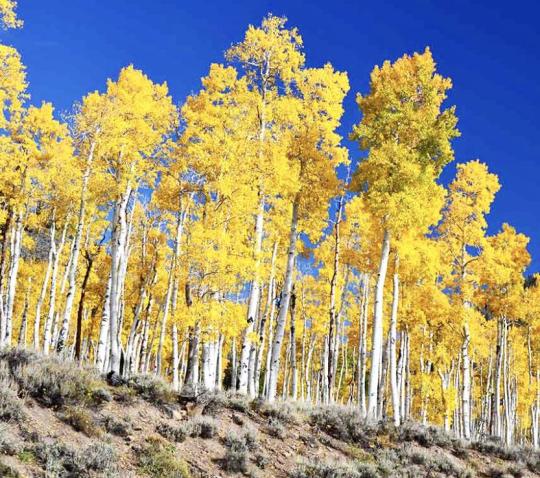
Pando tree in Fishlake National Forest in Utah via r/oddlysatisfying
1 note
·
View note
Text

Making Fire Sense on Monroe Mountain
At the start of October 2023, green conifers and golden aspen covered the slopes of Monroe Mountain in Utah’s Fishlake National Forest. Then, starting on October 9, these forests turned black as fire worked its way across the mountain. Flames and smoke were visible for miles.
Unlike wildfires sparked by lightning or accidentally by people, this fire was ignited deliberately with a fire-dripping device suspended from a helicopter. The burn (pictured above), managed by the Richfield Ranger District, aimed to reintroduce fire to the Monroe Mountain region. Fire promotes aspen regeneration and reduces accumulated brush and dead vegetation that could fuel a larger uncontrolled fire.
The managed, or “prescribed” burn also provided an opportunity for researchers to closely examine a high-intensity fire. Dozens of scientists from the Forest Service and other organizations and universities collected data from the ground and from the sky as part of FASMEE, the Fire and Smoke Model Evaluation Experiment. Scientists with NASA’s FireSense project participated, too, collecting data that could ultimately aid wildland fire managers in the future.
“Participating in the prescribed burn offered NASA an opportunity to test technologies and demonstrate their effectiveness in supporting wildland fire management across the life cycle of a fire,” said Michael Falkowski, program manager for the Applied Sciences Wildland Fire program at NASA Headquarters and lead of FireSense.

According to the Monroe Mountain Aspen Ecosystem Restoration Project led by the Forest Service, the number of aspens on this landscape has declined by 70 percent in the past 200 years due to overbrowsing and a lack of fire. Beyond losing a scenic icon of autumn, the decline has implications for the plants and animals supported by the aspen ecosystem, such as elk and mule deer.
In the past, this part of south-central Utah would burn about every 18 years, according to Linda Chappell, a fire ecologist (retired) with the Forest Service. But a history of fire prevention and suppression has allowed conifers to encroach on stands of shade-intolerant aspen. Efforts to cut down the conifers has not been enough. Aspens need fire.
The photo below (top) shows the South Monroe burn on October 18 after the prescribed burn had mostly run its course. Puffs of smoke (not visible) occasionally rose from the still-smoldering hillside that day. In all, fire managers successfully burned about 1,400 acres (5.7 square kilometers) of forest. It remains to be seen if new aspen shoots will emerge from the blackened ground.
Prescribed burns do not replicate the 18-year cycle exactly. Fire managers have to consider things like fuel moisture, proximity to people and private land, and the amount of resources and time invested in each burn. But they have an increasing array of tools, data, and expertise to help them identify the best weather windows for conducting safe and effective burns, the places that would benefit the most from managed fire, and the best ways to minimize fire’s impact on people.


Aiding that effort is FASMEE, the multi-agency experiment led by the USDA Forest Service Pacific Northwest Research Station. The burn on Monroe Mountain in October 2023 was the fourth FASMEE-affiliated burn in Fishlake National Forest since 2019, among others across the U.S. West and Southeast.
Beyond the benefits for aspen recovery, the Monroe Mountain burn is informing over a dozen research projects. Some of them are ecological studies, such as an investigation to find out how bats respond to fire, led by Boise State University, and an assessment of post-fire aspen regeneration, led by the Tall Timbers Research Institute. Other projects will improve the models that inform firefighting strategies, smoke forecasts, and carbon and climate research.
“This is the perfect natural laboratory for fire,” said Jacquelyn Shuman, a forest ecologist at NASA’s Ames Research Center, and project scientist for NASA’s FireSense project.
High-intensity prescribed burns, like the one on Monroe Mountain, closely resemble wildland fires. But because the fires are planned, scientists can measure the landscape before the burn, as well as during and after. They can probe the soil’s moisture content, set up air sampling devices, and map the forest’s fuel load and calculate fuel consumption.
They balance all these tasks while staying flexible to just-right burn conditions; that is, a period of dry, not-too-windy weather, followed by a period of snow or rain that ensures the fire will die out.
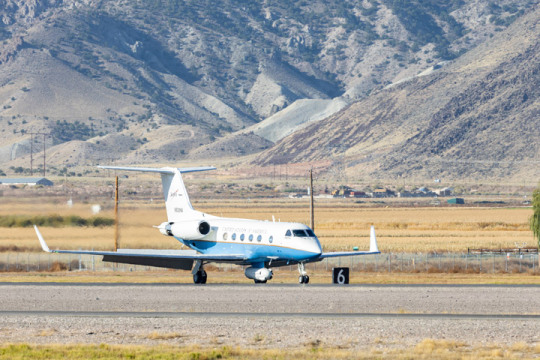
Three NASA aircraft arrived in Richfield for the burn. Their participation in FASMEE was a first for FireSense, a NASA project that includes field campaigns to evaluate and improve science resources delivered to operational fire agencies. One of the aircraft, NASA’s Gulfstream III, is pictured above at the Richfield Municipal Airport on October 17, 2023.
“The airborne perspective will allow FASMEE researchers to better understand fire behavior and smoke production, and hopefully someday support increasing the use of beneficial prescribed fire to mitigate fire risk, restore degraded ecosystems, and protect human communities from catastrophic fire,” Falkowski said.
Airborne data collected before, during, and after the burn on Monroe Mountain will help characterize the entire life cycle of the fire, covering a larger area than is possible from ground-based instruments alone. Data from the radar and optical instruments aboard the aircraft will be used to map the forest’s composition and the moisture in its soils and fuels. Researchers can also track how the fire grew, whether it was flaming or smoldering, and the concentration of smoke particles it lofted into the air.
“Like an angler might use a depth finder to help them decide where to fish, fire managers can use airborne data to help make decisions about a fire,” Shuman said. She noted that these data are a tool, supplementing fire managers’ knowledge of the landscape with additional insights from above. “The ultimate goal of FireSense is to improve the experience for fire managers and to mitigate the risk for firefighters and communities.”
Photo (top) by Grace Weikert/NASA GSFC. All other photos by Milan Loiacono/NASA ARC. Satellite image by Wanmei Liang/NASA Earth Observatory, using MODIS data from NASA EOSDIS LANCE and GIBS/Worldview. Story by Kathryn Hansen.
0 notes
Link
NASA / Grace Weikert Flames burn orange through green conifers and golden aspen on the slopes of Monroe Mountain in Utah’s Fishlake National Forest, sending gray and brown smoke billowing into the sky in this image from Oct. 9, 2023. This fire was intentionally set with a fire-dripping device suspended from a helicopter. The burn aimed to reintroduce fire to the Monroe Mountain region. Fire promotes aspen regeneration and reduces accumulated brush and dead vegetation that could fuel a larger uncontrolled fire. Scientists from NASA’s FireSense project, along with dozens of others from the Forest Service and other organizations and universities, collected data from the ground and from the sky as part of the Forest Service’s Fire and Smoke Model Evaluation Experiment. Observing a prescribed high-intensity fire gave NASA an opportunity to test technologies and demonstrate their effectiveness in supporting wildland fire management across the life cycle of a fire. Read more about fire’s effect on this region and what we can learn from studying fires. Image Credit: NASA/Grace Weikert
0 notes
Text
Studying a Planned Fire
Flames burn orange through green conifers and golden aspen on the slopes of Monroe Mountain in Utah’s Fishlake National Forest, sending gray and brown smoke billowing into the sky in this image from Oct. 9, 2023. This fire was intentionally set with a fire-dripping device suspended from a helicopter. The burn aimed to reintroduce fire to the Monroe Mountain […]
from NASA https://ift.tt/hof4Mi0
0 notes
Text


Pando (Latin for "I spread")] is a clonal organism representing an individual male quaking aspen (Populus tremuloides) that spans 106 acres and is both the largest tree by weight and the largest tree by landmass, and is also the largest known aspen clone. Pando was identified as a single living organism because each of its stems possess identical genetic markers. Each of its estimated 47,000 stems (ramets) are generally connected by a massive interconnected root system that coordinates energy production, defense and regeneration across its expanse. Located in the Fremont River Ranger District of the Fishlake National Forest along the transition zone between of the Colorado Plateau and Basin and Range in south-central Utah, United States, Pando lives 0.43 miles west of Fish Lake, the largest natural mountain freshwater lake in Utah.
more on wiki
0 notes
Video
My Forest Casa Amongst the Aspens of Utah by Mark Stevens
Via Flickr:
A setting looking up and to the south while taking in views of spring time in this aspen grove in the Fishlake National Forest. My thoughts on composing this image was to have a color contrast with the greens and yellows of the aspen leaves with that of the blue skies and clouds above. I liked the view of looking up as it gave a sense of perspective with height in the trees all around. I later worked with control points in DxO PhotoLab 5 and then made some adjustments to bring out the contrast, saturation and brightness I wanted for the final image.
#American Aspen#Aquarius Plateau#Aspen#Aspens#Azimuth 171.40#Blues Skies with Clouds#Canyonlands#Colorado Plateau#Day 3#DxO PhotoLab 5 Edited#Fishlake National Forest#Intermountain West#Landscape - Scenery#Looking South#Looking Up#Looking up at Sky#Looking up at Sky through Trees#Looking up at Sky thru Trees#Looking up to Sky#Nikon D850#No People#Outside#Partly Cloudy#Populus tremuloides#Portfolio#Project365#Rolling Hillsides#Scenic Byway 12#Scenics - Nature#SnapBridge
0 notes
Photo

Amazing fact 😲 In Colorado Plateau (USA), the Fishlake Nation Forest is the home to one of the world’s oldest living organisms, The PandoTress. It’s network of roots is said to be an immense 80,000 years old. Book your flights with farefirst.com , available on Android, iOS, Website, and your favorite voice assistants. #FareFirst #cheapflights #travel #wanderlust #vacation #explore #travelblog #exploretocreate #colorado #forest
0 notes
Text
Pando the tree
Above ground, Pando appears to be a grove of individual trees, like any other grove. It was overlooked, for years. But underground everything is connected by a single and vast root system. It is one tree. A one-tree-forest. Pando is now under threat from cattle grazing, deer and climate change.
Pando spans about 107 acres of Utah’s Fishlake National Forest is one of the world’s largest organisms: a forest of some 47,000 genetically identical quaking aspen trees, which all stem from a single root system. Pando, as the organism is known (its name is Latin for “I spread”), has been growing for at least 80,000 years. But according to Yasmin Tayag of Inverse, the grove’s health has declined dramatically over the past few decades. The tree weighs about 13 million pounds which makes Pando is the world’s largest organism by mass. Quaking aspens can reproduce by disseminating seeds, but more frequently, they send up sprouts from their roots and form a mass of trees aptly known as a “clone.”
0 notes
